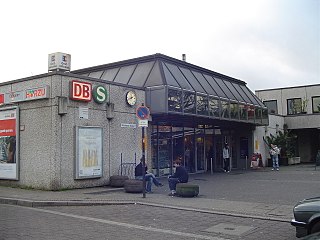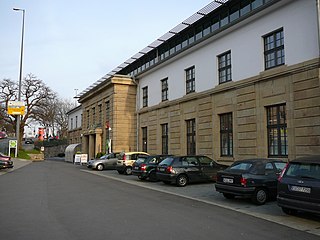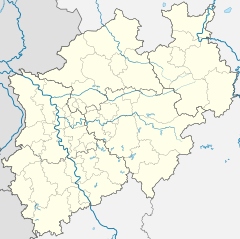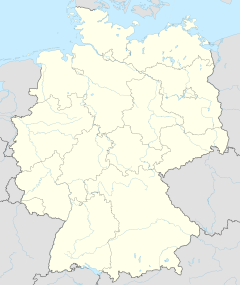
Düsseldorf Hauptbahnhof is the main railway station of Düsseldorf, the state capital of North Rhine-Westphalia, Germany.
Duisburg Hauptbahnhof is a railway station in the city of Duisburg in western Germany. It is situated at the meeting point of many important national and international railway lines in the Northwestern Ruhr valley.

Essen Hauptbahnhof is a railway station in the city of Essen in western Germany. It is situated south of the old town centre, next to the A 40 motorway. It was opened in 1862 by the Bergisch-Märkische Eisenbahn. However, the station was not the first in Essen: as the station called Essen on the Köln-Mindener Eisenbahn was opened in 1847.

Dortmund Hauptbahnhof is the main railway station in Dortmund, North Rhine-Westphalia, Germany. The station's origins lie in a joint station of the Köln-Mindener Eisenbahn and Bergisch-Märkische Eisenbahn which was built north of the city centre in 1847. That station was replaced by a new station, erected in 1910 at the current site. It featured raised embankments to allow a better flow of traffic. At the time of its opening, it was one of the largest stations in Germany. It was, however, destroyed in an Allied air raid on 6 October 1944.

Oberhausen Hauptbahnhof is a railway station in Oberhausen, North Rhine-Westphalia, Germany. The station was opened in 1847 and is located on the Duisburg–Dortmund railway, Arnhem-Oberhausen railway, Oberhausen–Duisburg-Ruhrort railway and Oberhausen-Mülheim-Styrum railway and is served by ICE, IC, RE and RB services operated by Deutsche Bahn, Abellio Deutschland, NordWestBahn and Eurobahn.

Witten Hauptbahnhof is a railway station in the town of Witten in western Germany. It is situated southwest of the town.

The S28 Regiobahn is a S-Bahn line in the Rhine-Ruhr S-Bahn network. It is operated by Transdev Rheinland GmbH as a subcontractor of Regiobahn Fahrbetriebsgesellschaft mbH, who is the PSO operator on behalf of Verkehrsverbund Rhein-Ruhr (VRR).

Line S7 is an S-Bahn service on the Rhine-Ruhr network in the German state of North Rhine-Westphalia, between Wuppertal and Solingen. The line has been operated by RheinRuhrBahn since 10 December 2023 at 20-minute intervals, using Alstom Coradia LINT 41 diesel multiple unit vehicles.

Line S 9 is an S-Bahn line on the Rhine-Ruhr network, operated by DB Regio. It runs from Recklinghausen Hbf / Haltern am See in the north through Gladbeck West - Essen Hbf to Hagen (Westphalia) Main Station in the south. During the day two services per hour run between Wuppertal and Gladbeck West, one service per hour between Gladbeck and Recklinghausen Hbf and Gladbeck and Haltern am See and one service per hour between Wuppertal and Hagen, using FLIRT 3XL electric multiple units.

The Witten/Dortmund, Oberhausen/Duisburg railway is one of the most important railways in Germany. It is the main axis of long distance and regional rail transport on the east–west axis of the Ruhr and is served by Intercity-Express, InterCity, Regional-Express, Regionalbahn and S-Bahn trains.

The Elberfeld–Dortmund railway is a major railway in the German state of North Rhine-Westphalia. It is part of a major axis for long distance and regional rail services between Wuppertal and Cologne, and is served by Intercity Express, InterCity, Regional Express, Regionalbahn and S-Bahn trains.

Düsseldorf-Gerresheim station is a through station in the district of Gerresheim in the city of Düsseldorf in the German state of North Rhine-Westphalia. The station was opened along with the Düsseldorf–Elberfeld railway from Düsseldorf to Erkrath by the Düsseldorf-Elberfeld Railway Company on 20 December 1838. It has two platform tracks and it is classified by Deutsche Bahn as a category 5 station. Its station building, which has been refurbished as Kulturbahnhof is the oldest extant station building in Germany.
The Düsseldorf-Derendorf–Dortmund Süd railway is a partially closed line in the German state of North Rhine-Westphalia from Düsseldorf-Derendorf station to Dortmund South station. Parts of it are still busy, including two sections used for the Rhine-Ruhr S-Bahn.

Wuppertal-Oberbarmen station is located in the city of Wuppertal in the German state of North Rhine-Westphalia. Historically, it served as a significant railway junction, connecting to four railway lines. Presently, the station is served by two remaining lines: the Dortmund–Wuppertal main line and the branch line to Solingen.

Wuppertal Zoologischer Garten station is a station on the Düsseldorf–Elberfeld railway in the city of Wuppertal in the German state of North Rhine-Westphalia. The station building was heritage-listed on 31 August 1987. It is classified by Deutsche Bahn as a category 4 station.

Wuppertal-Steinbeck station is a station on the Düsseldorf–Elberfeld railway in the city of Wuppertal in the German state of North Rhine-Westphalia. The current station building was built in 1913 and it has been heritage-listed since 1991. It replaced an older station building that was built between 1860 and 1870. It is classified by Deutsche Bahn as a category 5 station.

Wuppertal-Unterbarmen station is located in the German city of Wuppertal in the German state of North Rhine-Westphalia. It is on the Düsseldorf–Elberfeld line and is classified by Deutsche Bahn as a category 4 station.

Remscheid Hauptbahnhof is a railway station in the Bergisch city of Remscheid in the German state of North Rhine-Westphalia. It is located in Willy-Brandt-Platz near central Remscheid and is classified by Deutsche Bahn as a category 5 station. Remscheid and Gevelsberg Hauptbahnhof are the only Hauptbahnhof stations in Germany to be served only by S-Bahn trains.

Wuppertal-Langerfeld station is a through station in the district of Langerfeld of the city of Wuppertal in the German state of North Rhine-Westphalia. The station was opened in 1948 on a section of the Elberfeld–Dortmund railway from Döppersberg, near the current Wuppertal Hauptbahnhof, to Schwelm that was opened by the Bergisch-Märkische Railway Company on 9 October 1847. It has two platform tracks and it is classified by Deutsche Bahn as a category 6 station.

Schwelm West station is a through station in the town of Schwelm in the German state of North Rhine-Westphalia. The station was opened on 29 May 1988 on a section of the Elberfeld–Dortmund railway from Döppersberg, near the current Wuppertal Hauptbahnhof, to Schwelm that was opened by the Bergisch-Märkische Railway Company on 9 October 1847. It has two platform tracks and it is classified by Deutsche Bahn as a category 6 station.






























